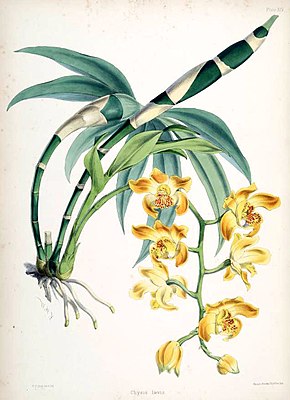Chysis
| Chysis | ||||||||||||
|---|---|---|---|---|---|---|---|---|---|---|---|---|

Chysis laevis , illustration |
||||||||||||
| Systematics | ||||||||||||
|
||||||||||||
| Scientific name of the sub-tribus | ||||||||||||
| Chysinae | ||||||||||||
| Schltr. | ||||||||||||
| Scientific name of the genus | ||||||||||||
| Chysis | ||||||||||||
| Lindl. |
The genus Chysis from the family of orchids (Orchidaceae) consists of ten plant species that are widespread in Central and South America. They grow there as epiphytes in damp forests.
description
The rungs emerge from the rhizome of the Chysis species at short intervals . The roots are richly branched, hairy and surrounded by velamen . The rungs are overhanging, up to 45 centimeters long and slightly thickened towards the upper end, so that a club-shaped or spindle-shaped pseudobulb is formed. In the lower area, the shoot is surrounded by membranous lower leaves, in the upper area there are six to twelve leaves arranged in two rows . The leaves are oval to broadly lanceolate in shape, thin paper-like, folded along the numerous visible longitudinal nerves. At the base they go into a leaf sheath that encompasses the shoot. A separating fabric between the leaf and the leaf base enables the leaves to be shed after a growing season.
One to three racemose inflorescences appear laterally from leaf axils in the lower area of the shoot. The inflorescences appear very early in the growing season, when the shoot and leaves are not yet fully developed. The resupinated flowers have a fleshy or waxy texture. The flower color is white, pink or yellow, the petals are often mottled and the lip has colored markings. The three outer petals are broadly oval, while the inner ones are narrower. The two lateral sepals are fused with an extension of the column ("column foot") and form a "chin" at the base of the flower. The lip is also attached to the base of the column, it is three-lobed, the lateral lobes are folded up around the column. In the middle of the lip there is a three- to seven-keeled callus . The column carries the opposite of the column axis reduces curved end stamen . Eight pollinia (four larger and four small) are present. They are held together by two oval plates made of anthers tissue. In some species, self-pollination takes place here each pollinia and the platelets are merged into a coherent mass that immediately after flowering to the scar gets. The hexagonal capsule fruit still carries the remains of the column when it is ripe.
distribution
The species of the genus Chysis have a wide distribution from Mexico in the north, across Central America and the Andes of South America to Peru. They settle at altitudes of 500 to 1000 meters.
They grow epiphytically in moist forests without a pronounced dry season. They often grow on the trunk of trees, i.e. in quite shady places, they are rarely found on rocks.
Systematics and botanical history
The genus Chysis was in 1837 by John Lindley with the type species Chysis aurea described . The genus name comes from the Greek χύσις chysis "pile" and means that (in self-pollinating species) the eight pollinia appear fused into one mass. Neither morphologically nor by means of DNA analysis can be identified any particularly close relatives. Even Rudolf Schlechter introduced in 1926 for these species own subtribe named Chysinae (also spelled Chysiinae) on. This is classified in the tribe Epidendreae , where it is a basal group, possibly the sister group to all other Epidendreae.
The following species are known in this genus:
- Chysis addita Dressler , Mexico and Guatemala
- Chysis archilae Chiron , Guatemala
- Chysis aurea Lindl. , Venezuela
- Chysis bractescens Lindl. , Central America: southern Mexico, Belize, El Salvador, Guatemala, Honduras, Nicaragua
- Chysis bruennowiana Rchb.f. & Warsz. (Syn .: Chysis pluricostata Dressler ), widespread from Honduras to Peru
- Chysis chironii Archila , Guatemala.
- Chysis guimaraensis Benelli & EMPessoa : The species first described in 2019 occurs in Brazil.
- Chysis laevis Lindl. (Syn .: Chysis orichalcea Dressler ), Mexico to Nicaragua.
- Chysis limminghei Linden & Rchb.f. , southeastern Mexico and northern Guatemala.
- Chysis tricostata Schltr. , Honduras, Costa Rica, Nicaragua
- Chysis violacea Dressler , Panama
literature
- CH Dodson, CA Luer: Orchidaceae part 2 (Aa-Cyrtidiorchis) . In: G. Harling, L. Andersson (Eds.): Flora of Ecuador . tape 76 . Botanical Institute, Göteborg University 2005, ISBN 91-88896-51-X , pp. 216-218 .
- Robert L. Dressler: Phylogeny and Classification of the Orchid Family . Cambridge University Press, 1993, ISBN 0-521-45058-6 , pp. 187-188 .
- Alec M. Pridgeon, Phillip Cribb, Mark W. Chase (Eds.): Genera Orchidacearum. Epidendroideae (Part one) . 2nd Edition. tape 4/1 . Oxford University Press, New York and Oxford 2005, ISBN 0-19-850712-7 , pp. 177-180 .
Individual evidence
- ^ Cássio van den Berg et al: An overview of the phylogenetic relationships within Epidendreae inferred from multiple DNA regions and recircumsription of Epidendreae and Arethuseae (Orchidaceae) . In: American Journal of Botany . tape 92 (4) , 2005, pp. 613–624 ( Cássio van den Berg's Web Site [PDF; accessed March 6, 2008]). Cássio van den Bergs Web Site ( Memento of the original from November 16, 2016 in the Internet Archive ) Info: The archive link has been inserted automatically and has not yet been checked. Please check the original and archive link according to the instructions and then remove this notice.
- ↑ a b c d e f g h i j k l Rafaël Govaerts (Ed.): Chysis. In: World Checklist of Selected Plant Families (WCSP) - The Board of Trustees of the Royal Botanic Gardens, Kew . Retrieved April 6, 2020.


